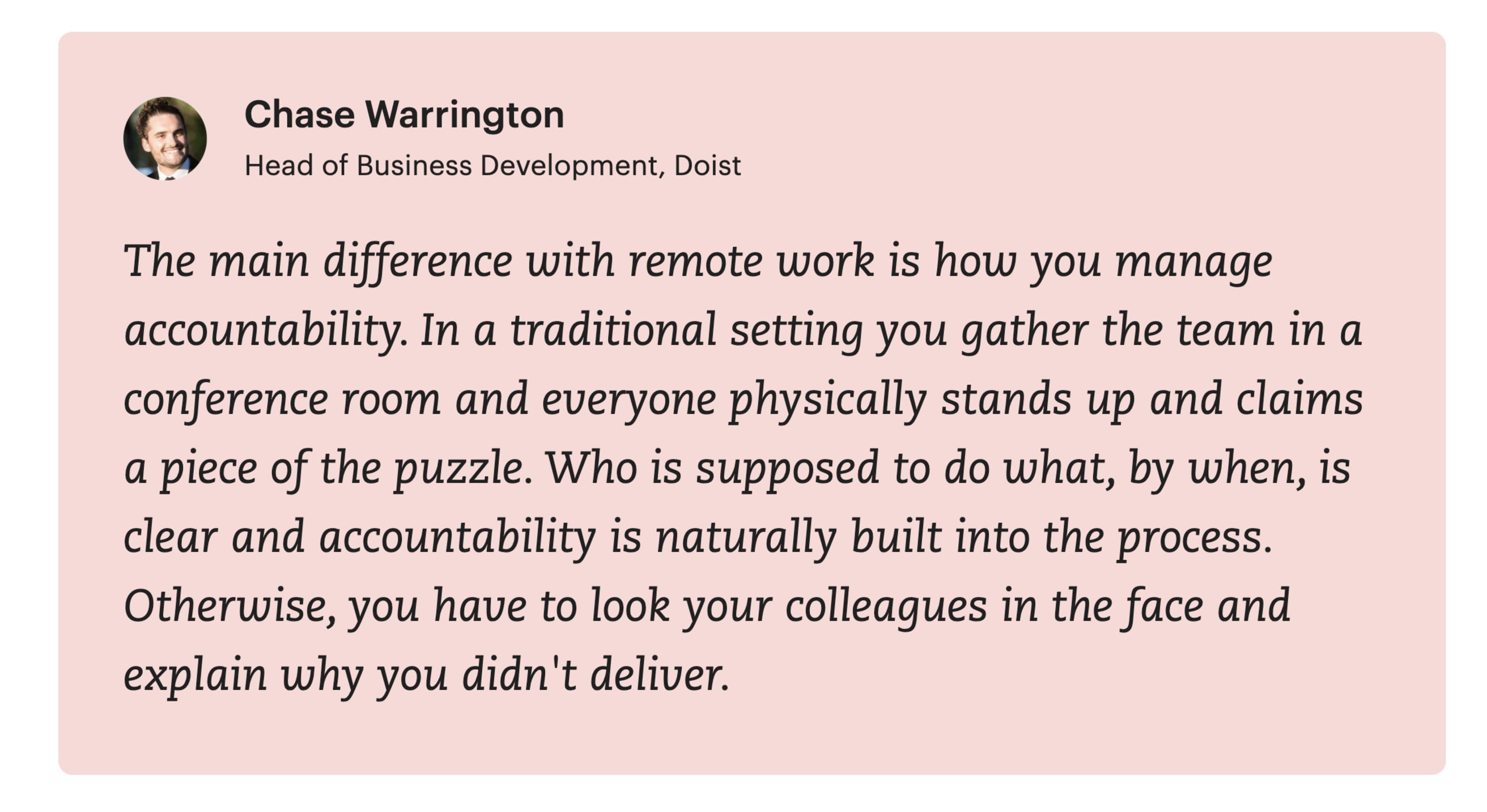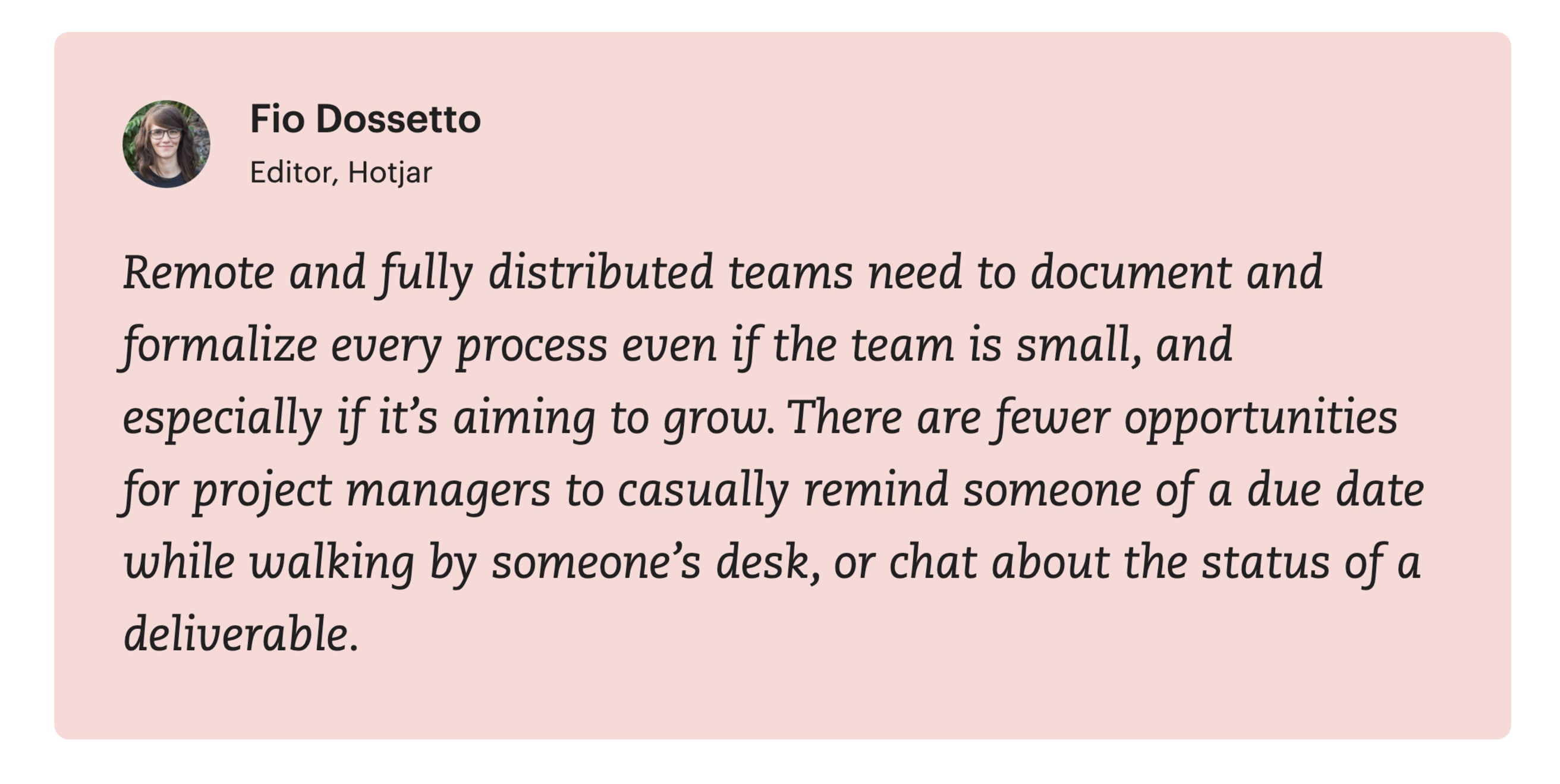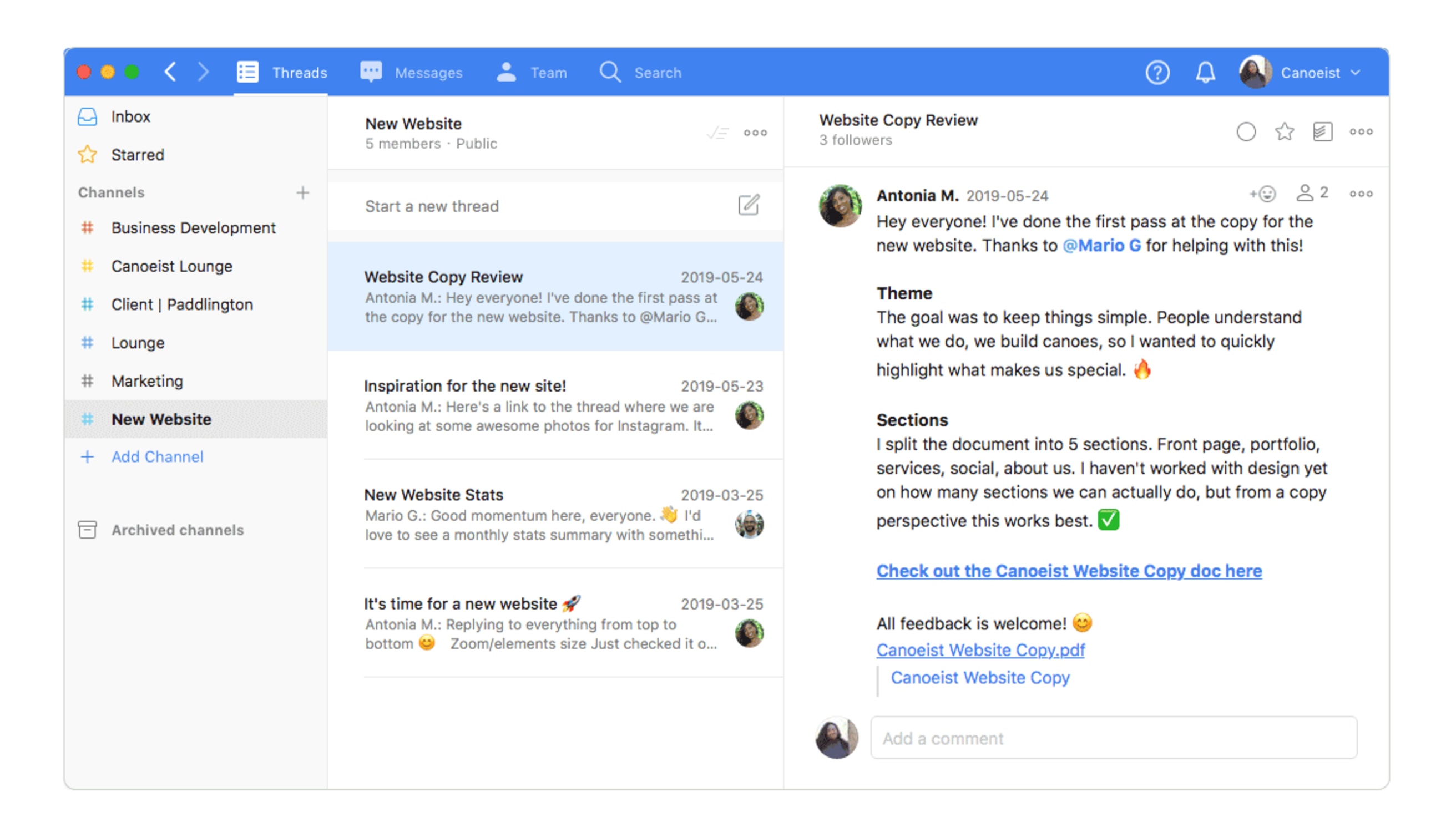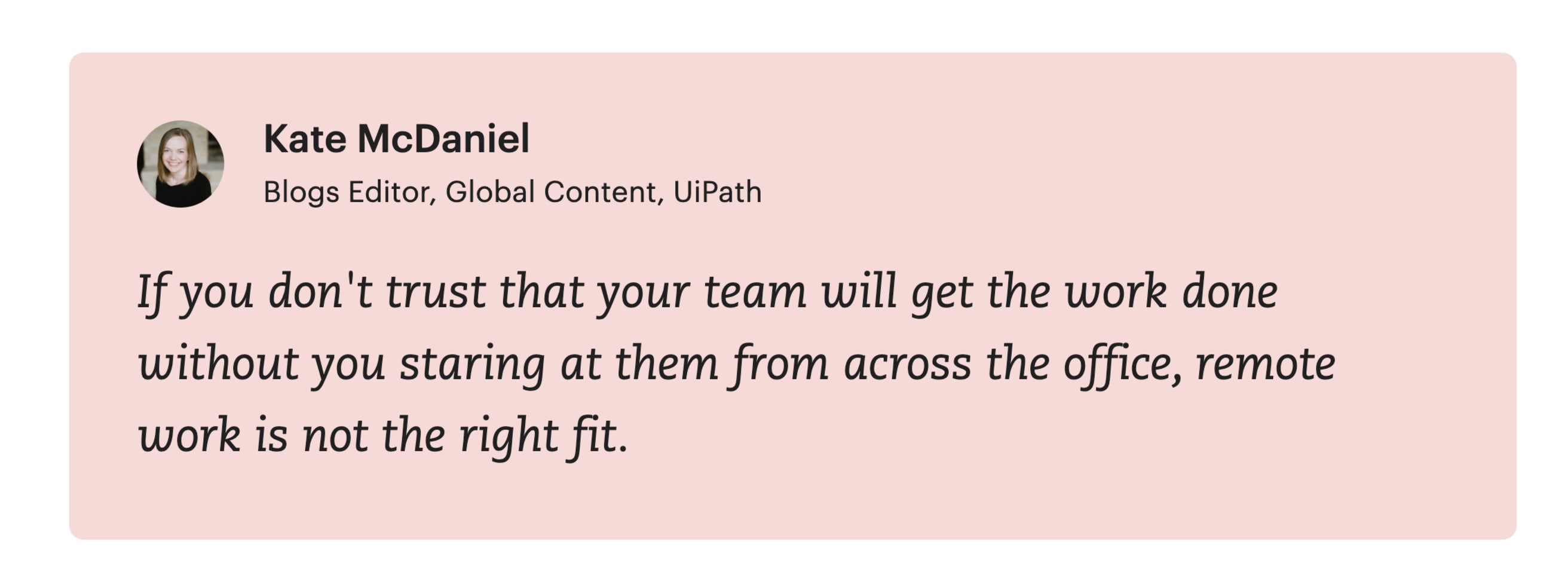At Doist, we have a lot of experience with remote projects. As a fully distributed team with 72 people spread across 29 countries, every single one of our projects is a remote project.
Year-long redesigns are the result of careful coordination that involves dozens of people across multiple timezones. Even smaller projects, like our updated Todoist Android Widget, are a joint effort between a lead designer in Germany, developers in Slovakia and Turkey, and a product marketer in Canada.
While (we hope) users' experience of our new product features and latest releases is seamless, the reality is that behind the scenes, remote projects have their ups and downs — communication challenges, collaboration issues, and accountability blunders. This article will discuss how remote teams can proactively set up projects so they succeed and provide tips on course correcting when things go wrong. We've included advice from our own experiences and added expertise from our friends at remote and distributed teams like Hotjar, Help Scout, Clearbit, Basecamp, and UiPath.
Taming the chaos of remote project tasks and processes
For non-remote teams, it's easy to take for granted the benefits of having the entire team in the same place. Shoulder-tap check-ins, quick chats around the water cooler, or catching up with team members over lunch—these might all seem like small interactions, but they all play a larger part in helping to move projects forward.
When your team is distributed though, these quick check-ins are more challenging. Without the option of catching someone in the hall or getting the team together in a conference room, managing remote projects requires a more diligent and transparent approach to maintaining tasks, deadlines, and processes.
Track every task and deadline in a central tool
After kicking off the project, add every task and corresponding deadline to your preferred project management tool, and assign each task to the responsible team member. Co-located teams might get away with being a bit more relaxed about updating tasks—but without regular status meetings, keeping your remote team on track takes diligence.
Keeping everything in a shared location ensures all team members know what they're responsible for and what they need to work on. Team members can't claim they haven't seen task assignments or didn't know something was due.
Our go-to tool for this is Todoist. We track all tasks, deadlines, and reference materials in a shared Todoist project.
We use a standard project template that includes all tasks related to setting up and coordinating a project team. You can use any of the dozens of online project management tools for your own projects, though—Trello, Basecamp, Asana, and Jira are popular options.

The project manager is not responsible for completing every task, but they are responsible for making sure every task gets completed. Make sure every task has a deadline to help keep team members accountable. Each task should also have a designated owner—someone who's ultimately responsible for making sure that task is completed on schedule.
Project managers who are also team members need to make sure that managing task deadlines and status updates does't become their full-time job. Once a week, they should make time in their calendar to take care of project management maintenance. Update the team on the progress they're making (or, on the contrary, the lack thereof), make sure all tasks have realistic deadlines and are properly assigned, and check in with team members to see if they're overloaded and need a hand.
Keep teammates accountable with quick status updates
Beyond asynchronous communication (which we'll cover later), creating accountability for remote workers is a huge shift for companies starting out with remote teams. Working remotely means shifting the burden of accountability from being top-down to being bottom-up: teammates are responsible for their own work and decisions.

So how can you build accountability within remote teams without micromanaging? The trick is to decentralize the process and let teammates hold each other accountable. Try trading in-person or videoconferencing stand-ups for asynchronous status updates. Once a week, have team members write a quick post answering three questions:
- What did I work on last week?
- What am I going to work on this week?
- What's blocking me from doing my best work?
Sharing in public lets everyone on the project team catch up on each other's work and saves the time and hassle of real-time status meetings.
Document every process and automate whenever possible
Of course, even the most organized projects can still fail if team members don't understand how to complete their tasks.

Whether you realize it or not, you most likely have a set of standard processes that teams repeat across each project. Documenting and sharing these activities—or even better, automating them—are key to making remote projects work.
Let's say your remote team is in charge of content marketing for a software product. You're probably already doing some (or all) of these processes:
- Notifying editors to review drafts
- Notifying designers about creating graphics or choosing stock photos
- Optimizing new articles for search
- Sending new articles to email subscribers
- Promoting new articles on social media
- Reporting on the performance of past articles
All these tasks are common across projects, making them perfect candidates for automation or, at the very least, standardization. Use tools like Zapier or IFTTT to automate low-value tasks so that team members spend the majority of their time on high-impact work and project managers can drive the project forward.
Now that you have all your tasks, deadlines, and processes under control, let's go over how you can keep your project-related conversations and discussions organized and accessible.
Keeping the lines of communication open
Effective communication is both the single most important part of managing remote projects and also the single most difficult.
Without effective discussion and collaboration among team members, it's nearly impossible to make projects successful. That said, when it comes to communication on remote teams, more (and faster) isn't always better.
Communication is difficult for many remote teams because they try and do what works well for co-located teams. For example, tools like Slack are great for real-time conversations, but they quickly break down when teams work across multiple time zones or when people want to sign off to focus on their work. It's something we learned the hard way at Doist: we used Slack for two years before quitting cold turkey.
The problem with real-time communication
Conversations in Slack happen on a one-way conveyor belt, leading team members to feel like they need to always be connected to make sure they don't miss important information.
UX designer Samuel Hulick explains the problem in the public break-up letter he wrote to Slack:
"I’m finding that “always on” tendency to be a self-perpetuating feedback loop: the more everyone’s hanging out, the more conversations take place. The more conversations, the more everyone is expected to participate. Lather, rinse, repeat."
For remote teams, that always-on mentality can quickly become a huge problem. Most workplaces, remote or not, rely almost unilaterally on synchronous —or real-time—communication tools, like Slack. A recent article from Vox described how managing Slack conversations can seem like a full-time job in itself, noting how people actually became more productive during a Slack outage in 2018. The constant stream of distractions hurts both team members' work and their well-being, killing productivity and keeping them from focusing on creating valuable work.

So what's the solution? Instead of relying on real-time communication, remote teams should work towards making asynchronous communication the norm.
Asynchronous communication lets people consume and respond to messages on their own time instead of on the sender's schedule. Whether teammates are in different cubicles or in different time zones, asynchronous communication means they'll always be on the same page.
“Asynchronous communication means I can take a step out for lunch,” writes Zach Holman, one of the earliest developers at remote company GitHub, “and catch up on transcripts when I get back. Asynchronous communication means I can ask my coworker a question and not worry about bothering her since she’ll get back to me when she’s available. Asynchronous communication means I can go to rural Minnesota and feel like I’m working from the office like normal.”
Solving the communication problem is so important that many teams make their own tools to communicate more effectively with their teams. Automattic, for example, created P2 as an internal message board built on WordPress to help keep their remote teams organized.
The benefits of asynchronous communication
Remote work is almost impossible without asynchronous communication. Nearly everyone from the remote companies we spoke to for this guide mentioned the importance of fostering better asynchronous communication practices for remote teams:
- Communication becomes non-critical. Less time firefighting means more time for deep work. “It's actually great to work in a setting where the fact that nothing is urgent is a given,” says Lucile Foroni from Doist, “because when you work that way, you actually realize that unless your site or app goes down, nothing is urgent.”
- Conversations are more meaningful and in-depth. Since messages aren't being missed on the one-way conveyor belt of synchronicity, a richer level of collaboration is possible. Discussions are accessible for much longer, and people can take time to digest information and respond on their own schedule.
- Teams can move more quickly. Even though asynchronous communication might feel slower than real-time communication at first, it actually helps team members work more efficiently by removing blocks like time zone differences. “By keeping all communication centralized in a place where teammates can collaborate regardless of time zone,” says Chase Warrington from Doist, “you'll allow the team to move much quicker.”
- Communication becomes more transparent. Defaulting to public conversations helps break down silos, reduce institutional knowledge and helps new team members quickly get up to speed without feeling overwhelmed.
- Work becomes less stressful. Without the expectation of an immediate response, people have complete control over their time and can disconnect and recharge without worrying about missing important conversations.
Now that you understand the benefits, let's examine how asynchronous communication looks like in practice.
Best practices for communicating asynchronously
Whether you're just starting to experiment with remote work or you've been fully distributed from the get-go, foster better communication with your remote project teams by using these best practices:
- Allow team members to work offline. Make it clear to your team that delayed responses are completely acceptable. Encourage team members to sign out when they need time to focus on deep work and to switch off entirely at the end of each day.
- Use the right tool for the job. Try switching from real-time chat apps like Slack to tools built for asynchronous communication like Twist. If switching isn't an option, focus on encouraging better habits within the tool you're already using.
- Avoid synchronous meetings when possible. “Status meetings are the worst kinds of meetings,” Jason Fried from Basecamp writes. “Eliminate them and you’ll actually know more, save a pile of money, and regain dozens of hours a month."
- Default to transparency. Document everything—decisions, notes, comments, discoveries, product specs, article ideas, or bug reports—in a shared tool like Dropbox Paper or Google Docs, where people can find it easily. Use email for outside communication only wherever possible.
- When in doubt, overcommunicate. “Overcommunication is key,” says Fio Dossetto from Hotjar. “When you and your remote co-workers overlap for maybe 3 or 4 hours a week only, even a small piece of missing information can derail an entire project.”
- Adapt your processes as you grow. What works for a team of five or six people will most likely fall apart for a team of 63 spread across 25 countries (trust us, we learned this the hard way). Don't be afraid to eliminate tools or processes if they're not working.

Breaking down time zone barriers
Dealing with time zones can be a huge adjustment for teams new to remote work. Schedules don't line up, fostering a team culture is harder, and teammates aren't available when you need them the most. “Sure, face-to-face communication has its place,” Chase Warrington from Doist says, “but if you try to do this when your teammates are spread across multiple time zones, you'll waste tons of time and energy, not to mention force people to work at odd hours.”
When the need for meetings inevitably arises, remember to always be empathetic towards team members' time zones. Janet Choi from Clearbit suggests being proactive by sharing your calendar and finding the best time for meetings. “Do the nice thing of handling any time zone math when setting up meetings or calls. For example, I'll ask about meeting in the other person's time zone.” Tools like Every Time Zone can show you the local time for each of your teammates, find out when they'll next be online, and pick meeting times that work for everyone.
There's a ton more we could cover on the importance of asynchronous communication—you can find out more about Twist and our bet on more meaningful communication.
But now, let's look at a few project management hurdles that remote teams often encounter, and some ways you can overcome them.
Solving common problems with remote projects
So what do you do when your remote project goes off the rails? Let's go over some of the common problems that remote teams run into and, more importantly, let's look at some solutions.
Communication breakdowns
Remote teammates have to trust each other to be effective.

But when most of your communication happens via the written word, it doesn't take much for people to misinterpret what others might be saying.
While tools like Twist make remote communication more manageable, misinterpretation is common. Messages can easily be interpreted differently by different people, and our human tendency to guess at others' intentions can often lead to a breakdown in communication. A message that seems fine to you might come across as brusque or even rude to some teammates in other countries.

As best you can, be aware of how your communication may come across, and clarify anything that could potentially be misunderstood. For example, instead of asking “When is task X going to be finished?” try asking, “It looks like we might miss our deadline for this project, and I'm trying to work out what absolutely needs to get done before we release. Just wondering if you need extra help to get task X wrapped up, or if we should put it on hold for now?”
Gregory Ciotti from Help Scout also recommends assuming miscommunication over malice. “Stick to assuming positive intent; when working with great people, you’ll rarely be wrong.” Encourage teammates to speak up if they feel like someone's coming across the wrong way—clearing up misunderstandings early helps prevent them from turning into bigger problems down the line.
Lack of responsiveness
Remote work means you can't drop in on teammates at any time, you might not get responses to your messages straight away, and your work hours are probably completely different from those of your colleagues.
You shouldn't expect people to respond immediately, but if you aren't getting a response at all, it's important to figure out what's wrong. This often happens when remote teammates feel isolated. Going days without contact can cause people to withdraw and stop contributing to the project, reducing the effectiveness of the team.
Combat this lack of responsiveness by fostering regular interactions between teammates—set up partnerships where two or more team members collaborate more closely on tasks, or have “buddies” check in on each other.
Unclear responsibilities
As project manager, you're responsible for making sure the project is delivered on schedule—but you're not always the one responsible for completing the actual work. When you can't stop by your teammate's office and ask them how things are going, it's easy to get confused about how far along the project really is and who's responsible for moving each task forward.
The best way to keep things on track is by setting clear expectations up front for who is accountable for each part of the project. Ideally, this should be part of the spec you create at the beginning of each project, and assignments should be agreed upon by all team members.
Make sure the whole team, along with any stakeholders, understands who's ultimately accountable for each part of the project. That way, when questions arise during the project, you can always refer back to the original plan to clarify responsibilities and keep the project moving forward.
Conflicting priorities
To manage your remote team's workload and hit your project deadlines, you must effectively prioritize each and every task. But working on multiple complex projects means you'll eventually end up juggling conflicting priorities, making it hard to meet deadlines and ensure that team members are working on the most important tasks.
No two priorities are equally important—and the best way to determine the order in which they should fall is to step back and consider the overall objective for the project. Is it more important to deliver a quality outcome late, or a reduced-scope product on schedule? Will adding resources make things any easier? When you encounter conflicts or need to make trade-offs, always prioritize the option that gets you closest to the original goal you outlined in the project spec.
Project management doesn't have to be a burden on remote teams, a distraction from the work itself. With the right tools and processes in place, you'll ship valuable remote projects more often, and team members will thrive in an environment that promotes autonomy, flexibility, and trust.
A version of this article originally appeared in the Twist Remote Work Guides.

